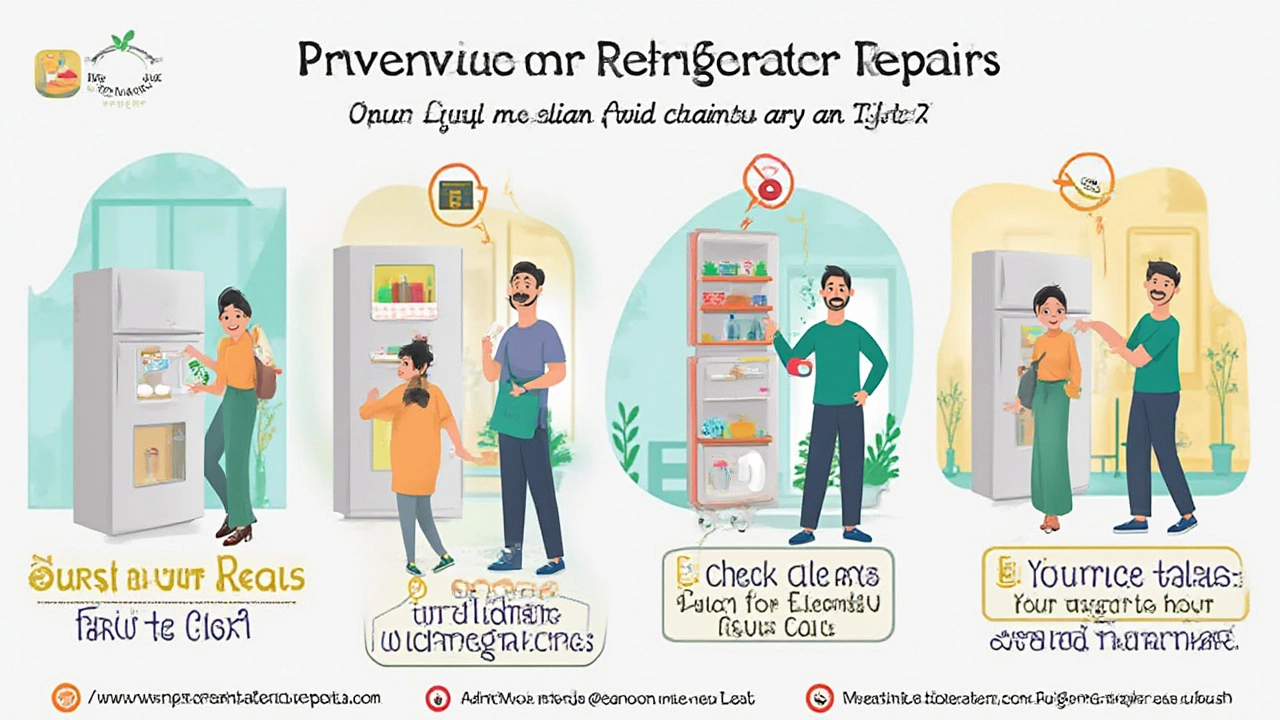You ever open your fridge, grab for the milk, and realize your once trusty appliance is sweating on the inside, or worse, just warm? The sudden dread isn’t just about spoiled food—it's that gut feeling something expensive has gone wrong. Everybody’s heard nightmare stories from neighbors or online about repair bills almost as high as the cost of a new fridge, but what really drives those prices sky-high? And can you do anything to avoid being the next horror story?
The Heart of the Fridge: Why Compressors Are King of Repair Bills
The number one most expensive thing to fix on a refrigerator, hands down, is the compressor. Think of the compressor as the heart of your fridge; it pumps refrigerant through coils, keeping the inside cold. When the compressor fails, the whole cooling process breaks down—no cold, no ice, and definitely no chance of saving those leftovers. On today’s fridges, especially fancy French-door or smart models, a compressor swap can run you anywhere from $500 to $1,500, sometimes even more. And that’s just the bill for the repair; it doesn’t include time missed from work waiting for the tech, or the ice you have to buy to rescue your groceries.
Compressors aren’t just costly because they’re complicated machines packed with metal coils and a beefy motor. The real kicker is that the job is labor-intensive—technicians have to handle refrigerant (which is tightly regulated for environmental reasons), cut and braze copper pipes, and get the new part in without damaging anything else. And as fridges get fancier, so do their compressors. Inverter compressors, used for better energy efficiency, can double the cost compared to old-school tech. All this means a broken compressor usually puts you at a crossroads: fix it for big bucks, or throw in the towel and shop for a new fridge.
What makes compressors even trickier is the parts themselves aren’t plug-and-play. It’s rare to find a generic fit, and big brands like Samsung, LG, or Whirlpool have unique components and requirements—with some only sold to certified repair pros. That means no DIY hacks for most folks. Maybe you feel up for a challenge, but discharging refrigerant is a job you’re forced by law to leave to the pros. And I’ll be honest—speaking as a dad who’s tried to fix a lot of things before calling for help—the chance of making things worse is sky-high if you push your luck here.
Here’s a table that lays out the average costs you might face:
| Refrigerator Part | Average Replacement Cost (USD) |
|---|---|
| Compressor | $500 - $1,500+ |
| Control Board | $300 - $800 |
| Condenser Coils | $200 - $400 |
| Evaporator Fan Motor | $200 - $350 |
| Thermostat | $100 - $250 |
It’s pretty wild to realize that in some cases, a compressor repair alone makes up half the price of a basic new fridge. That’s why technicians sometimes straight up tell people to start shopping instead of fixing.
Not Just the Compressor: Other Costly Refrigerator Repairs
The compressor is the star of expensive fridge fixes, but it’s not the only part that can blow your budget. The control board (that’s the computer brain that manages everything your fridge does) is a surprise runner-up, often costing anywhere from $300 to $800 to replace. An issue with the control board can make a fridge stop running entirely or do bizarre things, like flip the ice maker on and off repeatedly—a classic example from my own kitchen one Friday night, just as I was packing Sidney’s lunch for a summer camp trip. There’s not much you can do with a fried board except replace it, and brands keep proprietary chips that aren’t available at the corner hardware store.
Another costly culprit is the sealed system. This term covers all the parts that keep the refrigerant sealed in—evaporator coils, condenser coils, and refrigerant lines. Leaks in the sealed system are tough to spot and even harder (and pricier) to fix. You need a licensed technician, special tools, and often end up replacing major parts. If you spot oily residue under or behind your fridge, or if cold air just isn’t getting cold, odds are your sealed system is leaking. Most techs will warn you right up front: it might be more expensive than the fridge is worth.
Even the water and ice system can get you into deep water—literally and financially. Fixes for broken ice makers, clogged water lines, or failed inlet valves can run up a few hundred bucks on their own. Multiply that cost if you’ve got a high-end fridge loaded with smart features. Electronic panels, fancy LEDs, and touchscreen displays look cool, but they add more things that can break and hike up parts prices.
Recently, some high-tech fridges have started using parts that are only available as part of a bigger, more expensive module. That means a tiny electrical fault might require replacing an entire section, not just the $20 part. My advice? Find out your fridge’s part replacement policies before you buy one—this info isn't usually in the glossy brochure, but trust me, you’ll want to know before things go sideways.

Spotting Trouble Early: Warning Signs Before the Big Breakdown
Replacing a compressor is never anyone’s idea of a good time, but most of the time, you’ll get warning signs before your fridge goes kaput. Catching issues early gives you a fighting chance to avoid a mammoth bill. Here’s what to keep an eye (and ear) out for:
- Loud clicking, buzzing, or humming from the back or bottom of the fridge.
- Food spoiling faster than it should, or weird temperature swings inside.
- Lots of frost on the freezer walls, even after you defrost it.
- Warm spots or moisture collecting inside the fridge compartment.
- Ice maker not making ice, or water dispenser trickling or stopping completely.
If your fridge is more than six or seven years old, these signs are like road flares warning you of trouble. Newer fridges can sometimes be trickier—those computer boards can cover up problems until something critical fails. Some models have error code displays. If you spot something like “Er” or “CF” or any blinking message, look it up in your manual (or online with your model number). Sometimes, a control board reset or replacing a cheap sensor will buy you time, but don’t count on it lasting if there are bigger issues lurking.
On more than one occasion, my kid Sidney caught a buzzing sound that turned out to be the first sign of a fan motor dying in our ancient fridge. Sometimes, a good ear is all you need. If you’re handy and not afraid of a little YouTube DIY, you can carefully check the coils for dust and clean the back of the fridge. But any time you hear loud banging or smell something burning—don’t risk it. Unplug that fridge. No cold pizza slice is worth frying your kitchen or worse.
Real Ways to Sidestep Shocking Repair Bills
Avoiding a jaw-dropping fridge repair bill is mostly about two things: regular maintenance and choosing the right fridge in the first place. Here’s what’s worked for me and saved a lot of future headaches (and dollars):
- Clean those condenser coils every six months. Use a vacuum or coil brush, especially if you have pets. It helps your fridge cool more efficiently and stops strain on the compressor.
- Keep the fridge and freezer loaded—but not packed. Air needs room to move. When there’s proper flow, the compressor doesn’t work as hard and lasts longer.
- Check door seals. If a dollar bill can easily slip out from a closed fridge door, replace those seals. It’s cheap and easy, and stops the cooling system from working overtime.
- Avoid rocking the fridge when moving it, or tipping it more than 45 degrees. Oil from inside the compressor can move somewhere it shouldn’t, causing damage when it’s flipped back upright.
- Don’t ignore weird noises or error codes. Small noises today often become big expenses tomorrow.
- Look for longer warranties on compressors and sealed systems. Some fridge makers, like LG and Samsung, offer up to 10-year compressor warranties, even on budget models. Read the fine print!
- Consider the brand’s track record. Brands with better technical support, parts availability, and clear repair policies tend to cost less in the long run, even if they’re not the cheapest sticker price upfront.
If you move a lot, pick a fridge model that’s easier for service techs to find parts for (think Whirlpool, GE, or Frigidaire). Avoid super complex or ultra-niche models unless you’re okay with paying a premium down the road. Since refrigerators are one of those appliances you really can’t live without for more than a few hours, it pays to choose practicality over fancy extras that might break as soon as the warranty is up.
And here’s a tip from experience: set reminders in your phone to check coil cleaning, door seals, and temperature every few months. It’s about as fun as flossing, but your budget will thank you when you don’t have to replace a compressor early.

When to Repair or Replace: Doing the Math
When the worst happens and your fridge’s compressor gives out, you end up facing a tough choice. Fix or toss? The basic rule-of-thumb from appliance pros is this: if the repair will cost more than half the price of a new, similar fridge, start shopping. With compressor repairs topping $1,000 on some models, the math leans hard toward replacement, especially if your fridge is pushing past its seventh birthday. The average fridge in American homes lasts about 13 years, but after the first five or six, odds of major breakdowns go up steadily.
Do some quick cost comparisons before making the call. Get a written quote from a reputable local repair tech—never just take a wild guess or trust a number over the phone. Ask what’s covered under any remaining warranty, since some compressors are covered longer than the rest of the appliance. Major retailers are usually strict about receipt dates, so keep those docs handy (preferably both paper and digital copies—learned that the hard way when my garage flooded last spring).
Here’s what usually tips the balance toward buying new:
- Your fridge is more than seven to eight years old and out of warranty.
- You’ve already had a major part replaced once, and another big thing fails.
- Most other parts are showing wear or acting weird—door handles loose, drawers cracked, ice maker unreliable.
- Your energy bills are creeping up and the fridge is running all day and night.
But there are times when a repair makes sense. Brand new fridge? Compressor fails inside warranty? Get it fixed, no question. Same if you’ve got a very high-end refrigerator with a built-in wine cooler, radar sensors, or fancy cabinetry panels—it can literally cost as much as a used car to replace. In that case, calling in a certified tech and paying the price is just part of owning a luxury appliance.
If you’re stuck waiting days for an official estimate or insurance claim (one summer thunderstorm fried half our appliances), stash coolers filled with ice in the meantime to keep food from being wasted. And check your home or renter’s insurance, since some policies cover appliance breakdowns related to power surges or accidents—even water leaks from in-door water lines.



